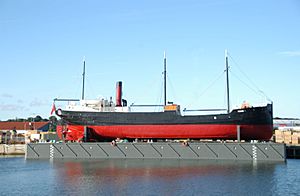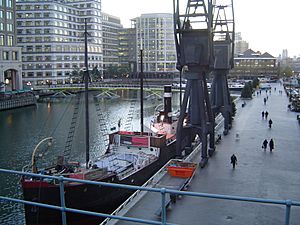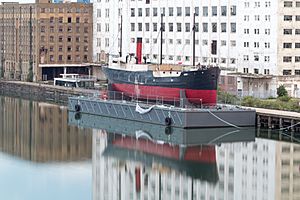SS Robin facts for kids
class="infobox " style="float: right; clear: right; width: 315px; border-spacing: 2px; text-align: left; font-size: 90%;" |+SS Robin
| colspan="2" style="text-align: center; font-size: 90%; line-height: 1.5em;" |
|} The SS Robin is a special kind of ship called a coaster. These ships are designed to carry goods like grain or steel along coastlines. The Robin is 350 GRT, which is a way to measure a ship's size based on its internal volume.
Built in London in 1890, she is the oldest complete example of her kind in the world. She was first owned by British companies. However, she spent most of her working life in Spain, where she was known as the Maria.
In 1974, the ship was bought back to be saved and restored. She was given her original name, Robin, again. Today, she is part of the National Historic Fleet. This means she is a very important part of Britain's history, like a Grade 1 Listed Building on land.
The SS Robin is now located in the Royal Victoria Dock in east London. In 2014, she opened as a museum, theatre, and educational centre.
Contents
- Early Years (1890-1900): Working in Britain
- Life as the Maria (1900-1974): A Spanish Adventure
- Coming Home (1974-2002): The Start of Restoration
- Restoration Journey (2002-2010): A New Plan
- The Robin Today (2010-Present): A Museum Ship
| History | |
|---|---|
| Name | Robin (1890–1900) |
| Owner |
|
| Builder | Mackenzie, MacAlpine & Co, then Robert Thomson, Orchard House Yard, Blackwall, London |
| Yard number | 26 |
| Launched | 16 September 1890 |
| Completed | November 1890 |
| Identification | IMO number: 5222287 |
| Fate | Sold to Spain 1900 |
| Name | Maria (1900–1974) |
| Owner |
|
| Fate | Purchased for preservaton 1974 |
| Name | Robin (1974–present) |
| Owner |
|
| Status | Museum ship |
| General characteristics | |
| Tonnage | 366 GRT (later 342 GRT) 550 DWT |
| Length | 143 ft (44 m) loa |
| Beam | 22.9 ft (7.0 m) |
| Depth | 11 ft (3.4 m) |
| Installed power | Triple expansion steam engine 152 ihp (113 kW) |
| Propulsion | Single screw |
| Sail plan | Originally schooner rigged |
| Speed | 9 knots (17 km/h; 10 mph) |
Meet the SS Robin: Her Design and Power
When the Robin was first built, she was about 43.5 meters (143 feet) long. Her width was about 7 meters (23 feet), and her depth was about 3.7 meters (12.2 feet). She could carry around 450 tons of cargo.
Her engine is a special type called a Triple expansion steam engine. This engine has three cylinders that use steam to create power. It was built in 1890 in Scotland. The engine could make the ship travel at a top speed of about 9 knots. A knot is a measure of speed for ships.
The Robin was also designed to use sails. She was described as a "steel screw 3-masted schooner." This means she had three masts and could use sails to help her move, even though she also had a powerful steam engine.
The Robin's Journey: A Ship's Story
The Robin was built by Mackenzie, MacAlpine & Co in London. She was launched on September 16, 1890. After being built, she was taken to Scotland to have her engine and other machinery installed. Once finished, she was registered in London. Her first owner was Arthur Ponsonby.
Early Years (1890-1900): Working in Britain
The Robin started her working life on December 20, 1890. Her first trip began in Liverpool. As a coaster, she usually stayed within certain coastal areas. However, her first journey took her further, to Bayonne in France.
She carried many different types of goods. These included grain, iron ore, scrap metal, and even large granite blocks. She sailed to many ports in Britain and nearby European countries. In 1892, the Robin was sold to Andrew Forrester Blackater and re-registered in Glasgow.
Life as the Maria (1900-1974): A Spanish Adventure
In 1900, the Robin was sold to new owners in Spain. She was renamed Maria. For the next 74 years, she had three different Spanish owners:
- From 1900 to 1913, she was owned by Blanco Hermanos y Compañia.
- From 1913 to 1965, she belonged to Hijos de Angel Perez y Compañia. During World War I, she carried iron for the French government. She was even escorted by two destroyers to protect her from German U-boats.
- From 1965 to 1974, Eduardo de la Sota Poveda owned her. She carried coal around the north coast of Spain.
The Maria's design stayed mostly the same until 1965. In 1966, she had a big update. Parts of the ship were removed or shortened. Her coal furnaces were changed to use oil fuel instead. After these changes, she continued her work.
Coming Home (1974-2002): The Start of Restoration
The Maritime Trust found the Maria in 1972. They decided she was important enough to save. In May 1974, they bought her just before she was going to be scrapped. In June 1974, she sailed back to London. She was given her original name, Robin, again.
The ship was restored at a cost of £250,000. Most of the work happened in 1974 and 1975. She was then moored in St Katharine Docks. Later, she moved to West India Quay. However, she started to fall into disrepair again.
In 2000, David and Nishani Kampfner bought the Robin for just £1. They wanted to turn her into a place for learning. In 2002, the SS Robin Trust was created. This group helps people learn about the ship's importance. Volunteers began working to restore this historic steamer.
Restoration Journey (2002-2010): A New Plan
The Crossrail project helped the SS Robin Trust with a loan of £1.9 million. This money allowed the ship to move to a dry dock for restoration. Before moving, her masts, funnel, and lifeboats were taken apart. She was then towed to a temporary mooring. Around this time, the Heritage Lottery Fund also gave the Trust a grant of almost £1 million.
In June 2008, the Robin began her first sea journey in 35 years. She was moved to Lowestoft for major structural repairs. The goal was to use the same building skills from 1890. However, a detailed check showed she was too fragile to float on her own again.
It was first thought that 40% of her steel would need replacing. But the check showed 80% would be needed. This would ruin her historical value. So, the Trust found a new idea: a pontoon. This would keep her floating without damaging her original structure. In 2010, the Robin was lifted by two cranes onto her new pontoon. She was then towed to Tilbury for a year.
The Robin Today (2010-Present): A Museum Ship
After three years of work in Tilbury, the Robin returned to east London in July 2011. This was where she was first built. More work was done inside the ship. In 2014, she opened as the SS Robin museum, theatre, and educational centre. This was in the Royal Victoria Dock in Newham. The Heritage Lottery Fund helped with another grant of over £950,000.
Later, she moved to the Millennium Mills Dock. Here, she had more restoration work. In 2015, she reopened to the public at the western end of the Royal Victoria Dock.
The Robin: An Arts & Education Centre
In 2002, David and Nishani Kampfner bought the Robin. They started the SS Robin Trust, which is a charity. Important people like Prince Philip and Jon Snow support the Trust.
The Trust turned the ship into an educational centre and photo gallery. During this work, the ship's original parts, like beams and the engine, were carefully saved and fixed. From 2003, the Robin worked as a learning centre. It hosted exhibitions, talks, and workshops. These events helped connect communities and worked with local schools. The gallery and classroom area were set up inside the ship's original cargo hold.




